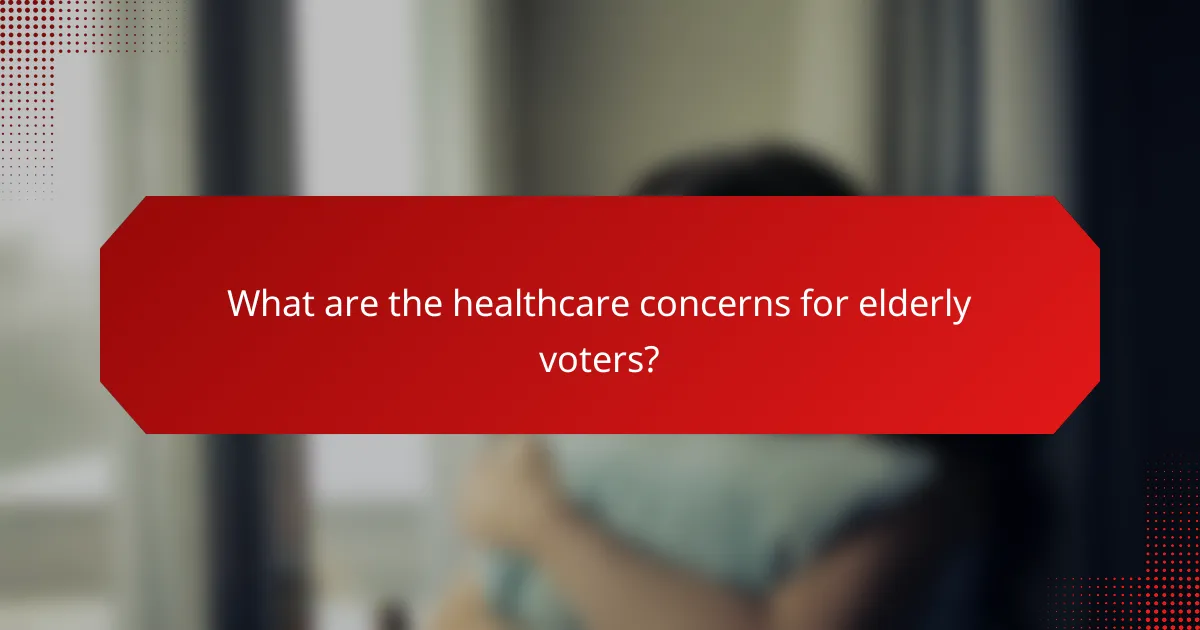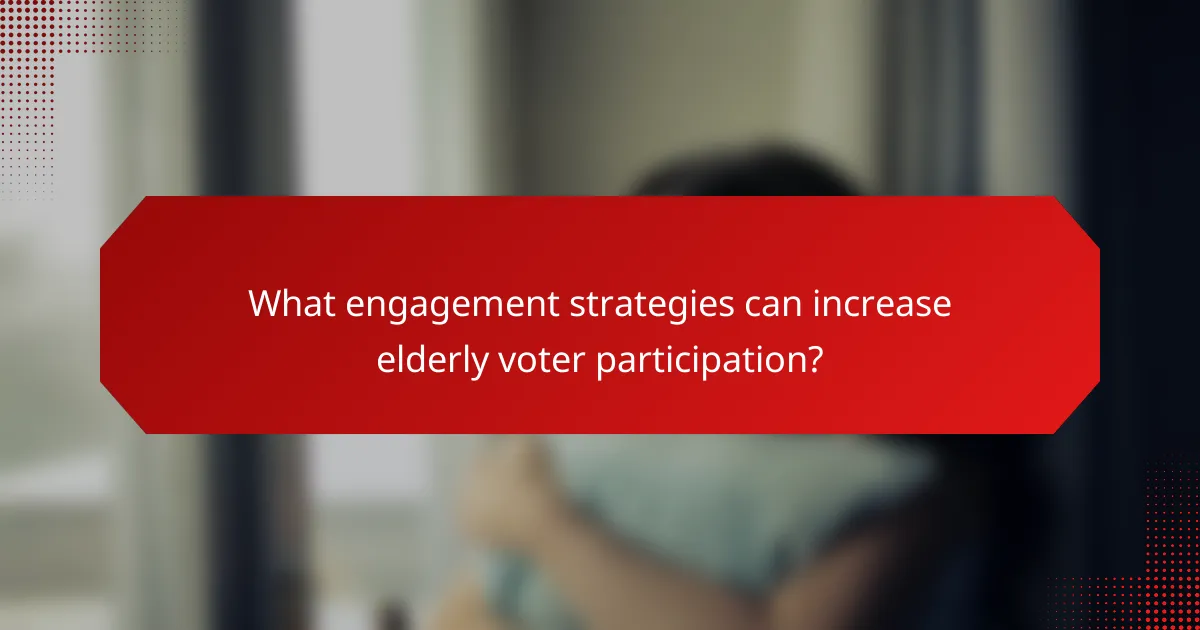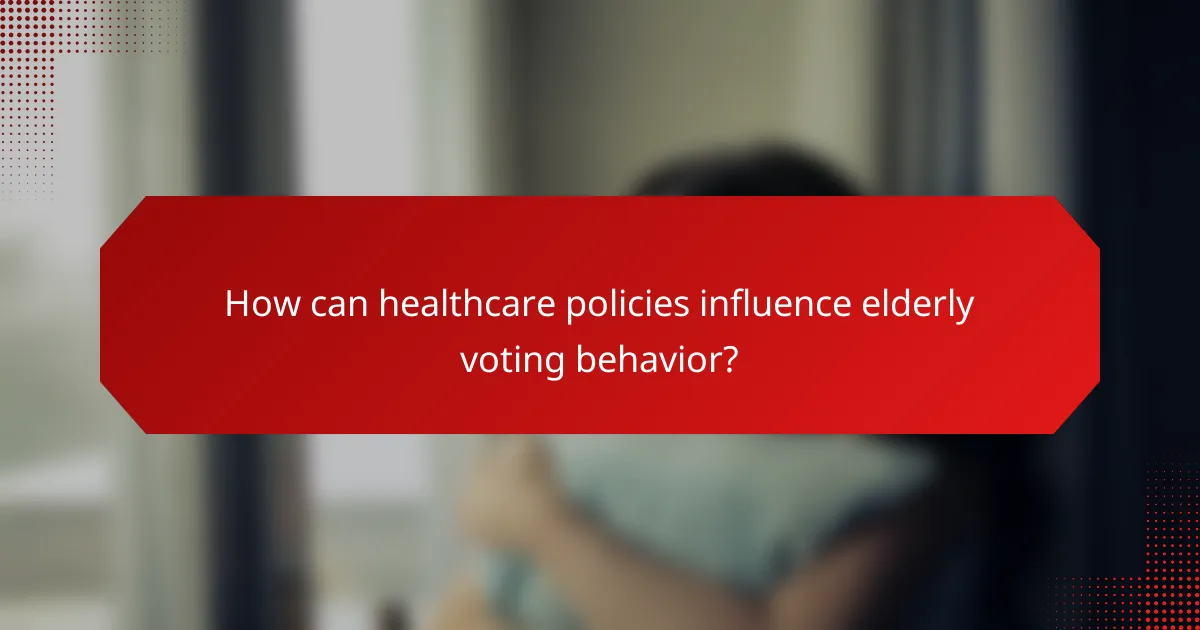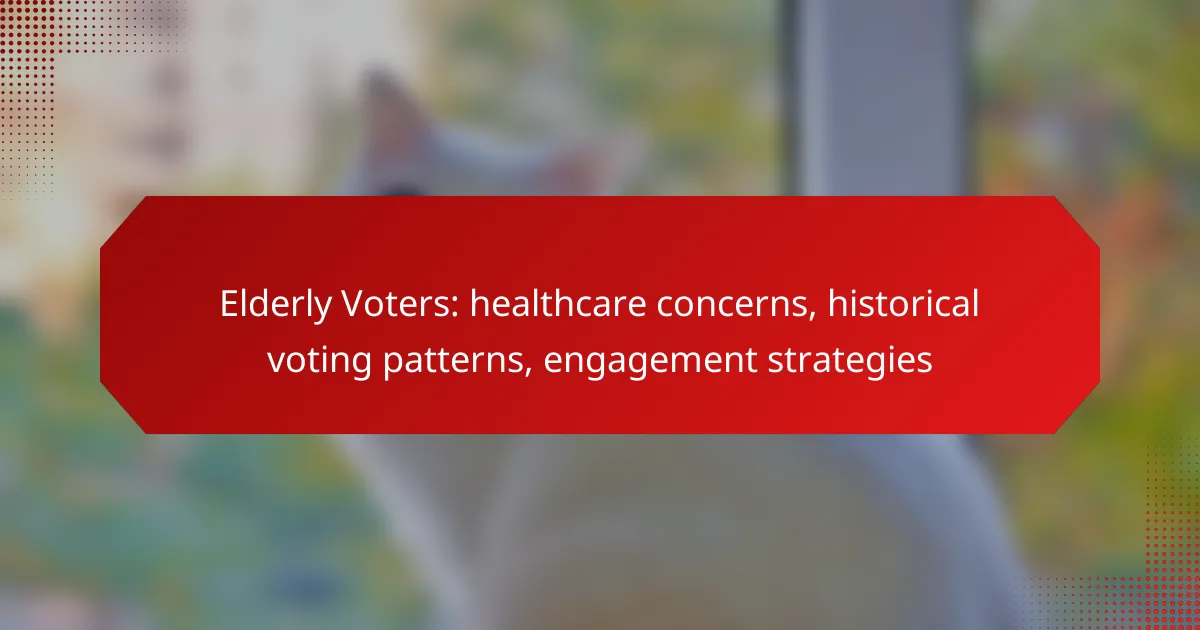Elderly voters play a crucial role in shaping electoral outcomes, yet they face unique healthcare concerns that can hinder their participation. Issues such as access to affordable medications and transportation to polling places significantly impact their ability to vote. Understanding historical voting patterns and implementing targeted engagement strategies can help ensure that older adults are informed and empowered to exercise their right to vote.

What are the healthcare concerns for elderly voters?
Elderly voters face several healthcare concerns that can significantly impact their ability to participate in elections. Key issues include access to affordable medications, availability of specialized geriatric care, the effects of chronic illnesses, transportation to polling places, and mental health support.
Access to affordable medications
Access to affordable medications is a critical concern for elderly voters, as many rely on prescriptions for chronic conditions. The rising costs of medications can lead to difficult choices between healthcare and other essential expenses. Programs like Medicare in the U.S. provide some relief, but gaps still exist, and many seniors may struggle to afford necessary treatments.
To mitigate these costs, seniors should explore options such as generic medications, patient assistance programs, and discount cards that can help lower out-of-pocket expenses.
Availability of geriatric care services
The availability of geriatric care services is vital for elderly voters who may require specialized medical attention. Many areas lack sufficient geriatricians or facilities that cater specifically to older adults, leading to challenges in receiving appropriate care. This shortage can affect their overall health and, consequently, their ability to engage in the voting process.
Communities should advocate for more geriatric services and consider telehealth options, which can provide easier access to specialists without the need for transportation.
Impact of chronic illnesses on voting
Chronic illnesses can significantly impact elderly voters’ ability to participate in elections. Conditions such as diabetes, heart disease, or mobility issues may limit their physical ability to travel to polling places or even affect their decision-making capacity. These health challenges can lead to lower voter turnout among seniors.
To address this, initiatives that provide assistance for those with chronic conditions, such as mail-in ballots or home voting options, can help ensure that elderly voters have a voice in the electoral process.
Transportation challenges to polling places
Transportation challenges are a major barrier for elderly voters trying to reach polling places. Many seniors no longer drive and may rely on public transportation, which can be limited or inaccessible in some areas. This situation can discourage them from voting, especially if polling locations are far from their homes.
Local governments can improve access by providing shuttle services or partnering with ride-sharing companies to offer discounted rides for seniors on election days.
Mental health support availability
Mental health support is crucial for elderly voters, as many face issues such as depression or anxiety, particularly during election cycles. The stress of navigating healthcare, financial concerns, and social isolation can exacerbate these conditions, impacting their willingness to vote.
Communities should prioritize mental health resources, including counseling and support groups, to help seniors manage these challenges and encourage their participation in the electoral process.

How do historical voting patterns affect elderly voter turnout?
Historical voting patterns significantly influence elderly voter turnout by shaping their engagement and participation in elections. Factors such as past political climates, social movements, and demographic changes have created a framework that affects how older adults approach voting today.
Trends in voting participation over decades
Over the past several decades, voting participation among elderly individuals has generally increased, particularly during presidential elections. In the U.S., for instance, turnout rates for those aged 65 and older have risen, often exceeding 70% in recent elections. This trend reflects a growing recognition of the importance of their voices in shaping policies that affect their lives.
However, participation can vary based on factors like socioeconomic status and education level. Older adults with higher education and income levels tend to vote at higher rates, while those facing economic hardships may struggle to engage fully in the electoral process.
Influence of major political events
Major political events, such as the Civil Rights Movement and the introduction of Medicare, have historically galvanized elderly voters. These events often highlight issues directly impacting older adults, prompting them to participate more actively in elections. For example, the expansion of healthcare access has been a critical concern for this demographic, driving turnout when candidates address these issues.
Additionally, significant political shifts, like the rise of populism, have also affected elderly voter engagement. Older voters may respond to candidates who resonate with their experiences and concerns, particularly regarding healthcare and social security.
Demographic shifts in elderly populations
Demographic shifts, including increasing diversity among elderly populations, are reshaping voting patterns. As the elderly population becomes more racially and ethnically diverse, their voting preferences and priorities may change, influencing overall turnout. For instance, Hispanic and Black seniors may prioritize different issues compared to their white counterparts, affecting their voting behavior.
Moreover, geographic distribution plays a role in turnout rates. Elderly individuals in urban areas may have different access to polling places and resources compared to those in rural settings, impacting their likelihood to vote. Understanding these demographic nuances is essential for engaging elderly voters effectively.

What engagement strategies can increase elderly voter participation?
Engagement strategies that effectively increase elderly voter participation include tailored outreach programs, technology use for education, transportation assistance, and partnerships with senior organizations. These approaches address the unique challenges faced by older voters, ensuring they are informed and able to participate in elections.
Community outreach programs
Community outreach programs are essential for connecting with elderly voters. These initiatives can include informational sessions at local senior centers, where volunteers provide details about upcoming elections and voting procedures. Engaging with seniors in familiar environments fosters trust and encourages participation.
Outreach can also involve door-to-door campaigns, where volunteers visit seniors at home to discuss voting and answer questions. This personal touch can significantly increase awareness and motivate elderly individuals to vote.
Use of technology for voter education
Utilizing technology can enhance voter education for the elderly. Online platforms can provide easy access to information about candidates, issues, and voting methods. Simple, user-friendly websites and social media campaigns can help disseminate this information effectively.
Webinars and virtual town halls can also be beneficial, allowing seniors to engage with candidates and ask questions from the comfort of their homes. Providing tutorials on how to use these technologies can further empower elderly voters.
Transportation assistance initiatives
Transportation assistance initiatives are crucial for elderly voters who may have mobility challenges. Local governments or organizations can offer shuttle services to polling places, ensuring seniors have reliable means to vote. These services can be scheduled in advance to accommodate voters’ needs.
Additionally, partnerships with rideshare companies can provide discounted or free rides for seniors on election days. Promoting these options through community outreach can help increase voter turnout among the elderly population.
Partnerships with senior organizations
Forming partnerships with senior organizations can amplify engagement efforts. Collaborating with groups that already have established trust within the elderly community can enhance outreach effectiveness. These organizations can assist in organizing events, distributing materials, and providing information on voting.
Joint initiatives, such as voter registration drives or informational workshops, can leverage the networks of these organizations to reach more seniors. This collaborative approach ensures that elderly voters receive consistent and relevant information about their voting rights and options.

What are the barriers to voting for elderly individuals?
Elderly individuals face several barriers to voting, including physical accessibility issues, restrictive voter ID laws, and limited awareness of their voting rights. These obstacles can significantly hinder their ability to participate in the electoral process.
Physical accessibility issues
Physical accessibility issues can include difficulties in reaching polling places, navigating stairs, or standing in long lines. Many elderly voters may require accommodations such as ramps, elevators, or seating areas to ensure they can cast their votes comfortably.
Election officials should prioritize accessibility by ensuring polling locations comply with the Americans with Disabilities Act (ADA) standards. Providing options for mail-in voting can also help alleviate these challenges for those with mobility limitations.
Voter ID laws and their impact
Voter ID laws can disproportionately affect elderly individuals, particularly those who may not have a current driver’s license or state-issued ID. In some states, the requirements for identification can create confusion and discourage elderly voters from participating.
To mitigate this impact, states should consider implementing alternative verification methods, such as signature matching or allowing sworn affidavits. Educating elderly voters about the specific ID requirements in their state can also help ensure they are prepared to vote.
Limited awareness of voting rights
Many elderly individuals may not be fully aware of their voting rights, including provisions for assistance and mail-in voting options. This lack of awareness can lead to lower participation rates among this demographic.
Community organizations and local governments should actively promote voter education campaigns targeting elderly populations. Providing clear, accessible information about voting rights and resources can empower seniors to engage in the electoral process confidently.

How can healthcare policies influence elderly voting behavior?
Healthcare policies significantly shape elderly voting behavior as they directly affect the well-being and financial security of older adults. Issues like access to affordable healthcare, prescription drug costs, and long-term care options often drive their electoral decisions.
Medicare and Medicaid impacts
Medicare and Medicaid are crucial programs for elderly voters, providing essential health coverage. Many seniors rely on Medicare for hospital and outpatient services, while Medicaid supports low-income individuals, including those needing long-term care.
Changes to these programs can sway voting behavior. For instance, proposals to cut benefits or alter eligibility criteria may lead to increased voter mobilization among seniors concerned about losing access to necessary healthcare services.
Engagement strategies for candidates should include clear communication about how their policies will affect Medicare and Medicaid. Providing specific examples of proposed changes and their potential impacts can help build trust and encourage informed voting among the elderly population.
